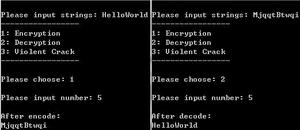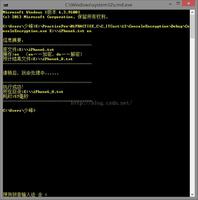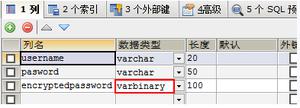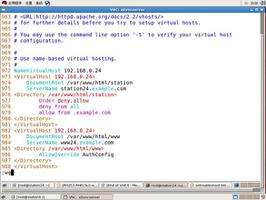Go语言 如何实现RSA加密解密
RSA是一种非对称加密算法,它的名字是由它的三位开发者,即RonRivest、AdiShamir和LeonardAdleman 的姓氏的首字母组成的(Rivest-Shamir-Adleman ),可用于数据加密和数字签名。
用于数据加密时,消息发送方利用对方的公钥进行加密,消息接受方收到密文时使用自己的私钥进行解密。
实现代码如下:
import (
"crypto/rsa"
"crypto/rand"
"crypto/x509"
"os"
"encoding/pem"
"fmt"
)
//生成RSA私钥和公钥,保存到文件中
func GenerateRSAKey(bits int){
//GenerateKey函数使用随机数据生成器random生成一对具有指定字位数的RSA密钥
//Reader是一个全局、共享的密码用强随机数生成器
privateKey, err := rsa.GenerateKey(rand.Reader, bits)
if err!=nil{
panic(err)
}
//保存私钥
//通过x509标准将得到的ras私钥序列化为ASN.1 的 DER编码字符串
X509PrivateKey := x509.MarshalPKCS1PrivateKey(privateKey)
//使用pem格式对x509输出的内容进行编码
//创建文件保存私钥
privateFile, err := os.Create("private.pem")
if err!=nil{
panic(err)
}
defer privateFile.Close()
//构建一个pem.Block结构体对象
privateBlock:= pem.Block{Type: "RSA Private Key",Bytes:X509PrivateKey}
//将数据保存到文件
pem.Encode(privateFile,&privateBlock)
//保存公钥
//获取公钥的数据
publicKey:=privateKey.PublicKey
//X509对公钥编码
X509PublicKey,err:=x509.MarshalPKIXPublicKey(&publicKey)
if err!=nil{
panic(err)
}
//pem格式编码
//创建用于保存公钥的文件
publicFile, err := os.Create("public.pem")
if err!=nil{
panic(err)
}
defer publicFile.Close()
//创建一个pem.Block结构体对象
publicBlock:= pem.Block{Type: "RSA Public Key",Bytes:X509PublicKey}
//保存到文件
pem.Encode(publicFile,&publicBlock)
}
//RSA加密
func RSA_Encrypt(plainText []byte,path string)[]byte{
//打开文件
file,err:=os.Open(path)
if err!=nil{
panic(err)
}
defer file.Close()
//读取文件的内容
info, _ := file.Stat()
buf:=make([]byte,info.Size())
file.Read(buf)
//pem解码
block, _ := pem.Decode(buf)
//x509解码
publicKeyInterface, err := x509.ParsePKIXPublicKey(block.Bytes)
if err!=nil{
panic(err)
}
//类型断言
publicKey:=publicKeyInterface.(*rsa.PublicKey)
//对明文进行加密
cipherText, err := rsa.EncryptPKCS1v15(rand.Reader, publicKey, plainText)
if err!=nil{
panic(err)
}
//返回密文
return cipherText
}
//RSA解密
func RSA_Decrypt(cipherText []byte,path string) []byte{
//打开文件
file,err:=os.Open(path)
if err!=nil{
panic(err)
}
defer file.Close()
//获取文件内容
info, _ := file.Stat()
buf:=make([]byte,info.Size())
file.Read(buf)
//pem解码
block, _ := pem.Decode(buf)
//X509解码
privateKey, err := x509.ParsePKCS1PrivateKey(block.Bytes)
if err!=nil{
panic(err)
}
//对密文进行解密
plainText,_:=rsa.DecryptPKCS1v15(rand.Reader,privateKey,cipherText)
//返回明文
return plainText
}
测试代码如下:
func main(){
//生成密钥对,保存到文件
GenerateRSAKey(2048)
message:=[]byte("hello world")
//加密
cipherText:=RSA_Encrypt(message,"public.pem")
fmt.Println("加密后为:",string(cipherText))
//解密
plainText := RSA_Decrypt(cipherText, "private.pem")
fmt.Println("解密后为:",string(plainText))
}
测试结果如下:

补充:golang中关于RSA加密、解密、签名、验签的总结
golang中关于RSA的加密、解密、签名、验签的使用主要在于使用x509及rsa package下相关的方法。
gocrypt是本人对一般常用的加/解密、签名/验签、hash的封装库,欢迎大家使用。
以下总结相关的各种变化类型:
1.秘钥、加密/签名字符串加密的格式
目前主要见到有hex及base64
(1)hex
针对hex的加解密
hex.DecodeString(s string)//解密
hex.EncodeToString(src []byte) string//加密
(2)base64
base64.StdEncoding.DecodeString(s string) ([]byte, error)//解密
base64.StdEncoding.EncodeToString(src []byte) string//加密
2.私钥的格式
解析私钥的方式如下:
(1)PKCS1
x509.ParsePKCS1PrivateKey(der []byte) (key interface{}, err error)
(2)PKCS8
x509.ParsePKCS8PrivateKey(der []byte) (key interface{}, err error)
3.采用的数字签名算法SHA
以下为RSA sign的不同说明:
(1)SHA1
hash := sha1.New()
hash.Write([]byte(originalData))
encryptedData, err := rsa.SignPKCS1v15(rand.Reader, prvKey, crypto.SHA1, hash.Sum(nil))
(2)SHA256
hash := sha256.New()
hash.Write([]byte(originalData))
encryptedData, err := rsa.SignPKCS1v15(rand.Reader, prvKey, crypto.SHA256, hash.Sum(nil))
4.RSA使用类型
主要有加密/解密、签名/验签4种方式,且加密/解密与签名/验签均是一个相反的过程。两对是根据对公钥及私钥的使用划分的。
加密/解密是采用公钥加密,私钥解密。
签名/验签是采用私钥签名,公钥验签。
(1)加密
rsa.EncryptPKCS1v15(rand io.Reader, pub *PublicKey, msg []byte) ([]byte, error)
(2)解密
rsa.DecryptPKCS1v15(rand io.Reader, priv *PrivateKey, ciphertext []byte) ([]byte, error)
(3)签名
rsa.SignPKCS1v15(rand io.Reader, priv *PrivateKey, hash crypto.Hash, hashed []byte) ([]byte, error)
(4)验签
rsa.VerifyPKCS1v15(pub *PublicKey, hash crypto.Hash, hashed []byte, sig []byte) error
5.具体的使用示例
(1)加密:采用sha1算法加密后转base64格式
func RsaEncryptWithSha1Base64(originalData,publicKey string)(string,error){
key, _ := base64.StdEncoding.DecodeString(publicKey)
pubKey, _ := x509.ParsePKIXPublicKey(key)
encryptedData,err:=rsa.EncryptPKCS1v15(rand.Reader, pubKey.(*rsa.PublicKey), []byte(originalData))
return base64.StdEncoding.EncodeToString(encryptedData),err
}
(2)解密:对采用sha1算法加密后转base64格式的数据进行解密(私钥PKCS1格式)
func RsaDecryptWithSha1Base64(encryptedData,privateKey string)(string,error){
encryptedDecodeBytes,err:=base64.StdEncoding.DecodeString(encryptedData)
if err!=nil {
return "",err
}
key,_:=base64.StdEncoding.DecodeString(privateKey)
prvKey,_:=x509.ParsePKCS1PrivateKey(key)
originalData,err:=rsa.DecryptPKCS1v15(rand.Reader,prvKey,encryptedDecodeBytes)
return string(originalData),err
}
(3)签名:采用sha1算法进行签名并输出为hex格式(私钥PKCS8格式)
func RsaSignWithSha1Hex(data string, prvKey string) (string, error) {
keyByts, err := hex.DecodeString(prvKey)
if err != nil {
fmt.Println(err)
return "", err
}
privateKey, err := x509.ParsePKCS8PrivateKey(keyByts)
if err != nil {
fmt.Println("ParsePKCS8PrivateKey err", err)
return "", err
}
h := sha1.New()
h.Write([]byte([]byte(data)))
hash := h.Sum(nil)
signature, err := rsa.SignPKCS1v15(rand.Reader, privateKey.(*rsa.PrivateKey), crypto.SHA1, hash[:])
if err != nil {
fmt.Printf("Error from signing: %s\n", err)
return "", err
}
out := hex.EncodeToString(signature)
return out, nil
}
(4)验签:对采用sha1算法进行签名后转base64格式的数据进行验签
func RsaVerySignWithSha1Base64(originalData, signData, pubKey string) error{
sign, err := base64.StdEncoding.DecodeString(signData)
if err != nil {
return err
}
public, _ := base64.StdEncoding.DecodeString(pubKey)
pub, err := x509.ParsePKIXPublicKey(public)
if err != nil {
return err
}
hash := sha1.New()
hash.Write([]byte(originalData))
return rsa.VerifyPKCS1v15(pub.(*rsa.PublicKey), crypto.SHA1, hash.Sum(nil), sign)
}
以上为个人经验,希望能给大家一个参考,也希望大家多多支持。如有错误或未考虑完全的地方,望不吝赐教。
以上是 Go语言 如何实现RSA加密解密 的全部内容, 来源链接: utcz.com/p/236137.html









